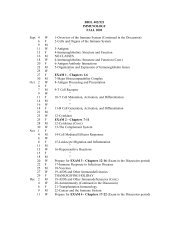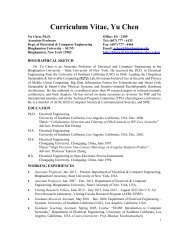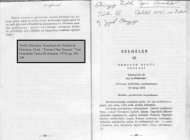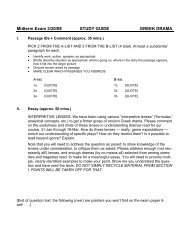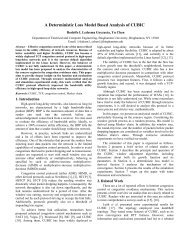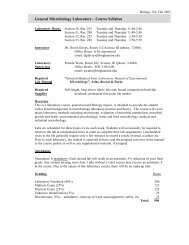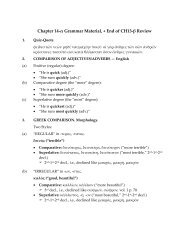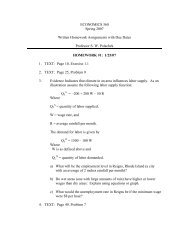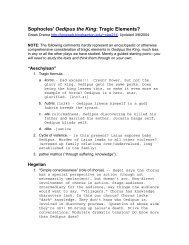Aristotle Poetics - Harvey.binghamton.edu
Aristotle Poetics - Harvey.binghamton.edu
Aristotle Poetics - Harvey.binghamton.edu
You also want an ePaper? Increase the reach of your titles
YUMPU automatically turns print PDFs into web optimized ePapers that Google loves.
<strong>Aristotle</strong> <strong>Poetics</strong> 14<br />
sode (epeisodos) all that comes in between two whole choral songs; 68 the exodos all that<br />
follows after the last choral song. In the choral portion the parodos is the whole first<br />
statement of the chorus; a stasimon, a song of the chorus without anapests or trochees; a<br />
kommos, a lamentation sung by chorus and actor in concert. 69 The parts of tragedy to be<br />
used as formative elements in the whole we have already mentioned; the above are its<br />
parts from the point of view of its quantity, or the separate sections into which it is divided.<br />
70 13<br />
10<br />
The next points after what we have said above will be these: (1) What is the poet to aim<br />
at, and what is he to avoid, in constructing his plots and (2) What are the conditions on<br />
which the tragic effect depends<br />
We assume that, for the finest form of tragedy, the plot must be not simple but complex;<br />
and further, that it must imitate actions arousing pity and fear, since that is the distinctive<br />
function of this kind of imitation. It follows, therefore, that there are three forms of plot<br />
to be avoided. (1) A good person must not be seen passing from happiness to misery, or<br />
(2) a bad person from misery to happiness.<br />
20<br />
The first situation is not fear-inspiring or piteous, but simply odious to us. The second is<br />
the most untragic that can be; it has no one of the requisites of tragedy; it does not appeal<br />
either to the human feeling in us, or to our pity, or to our fears. Nor, on the other hand,<br />
should (3) an extremely bad person be seen falling from happiness into misery. Such a<br />
story may arouse the human feeling in us, but it will not move us to either pity or fear.<br />
For pity is occasioned by undeserved misfortune, and fear by that of one like ourselves;<br />
so that there will be nothing either piteous or fear-inspiring in the situation. There remains,<br />
then, the intermediate kind of personage, a person not pre-eminently virtuous or<br />
just, whose misfortune, however, is brought upon him not by vice and depravity but by<br />
67 Parodos: chorus entry number.<br />
68 I.e., between two stasima, or choral entr’actes.<br />
69 kommoi are the often frenzied lamentation songs (chorus plus actor[s]) at or near<br />
the end of tragedies.<br />
70 The structure of a tragedy was typically as follows:<br />
• prologue<br />
• parodos (chorus entry number)<br />
• episode (a scene with actors)<br />
• stasimon (choral song between episodes)<br />
• additional episodes and stasima<br />
• kommos (lament)<br />
• exodos (finale, chorus exit)<br />
Solo arias and other types of choral and combined choral-solo numbers could be added to<br />
the mix.



